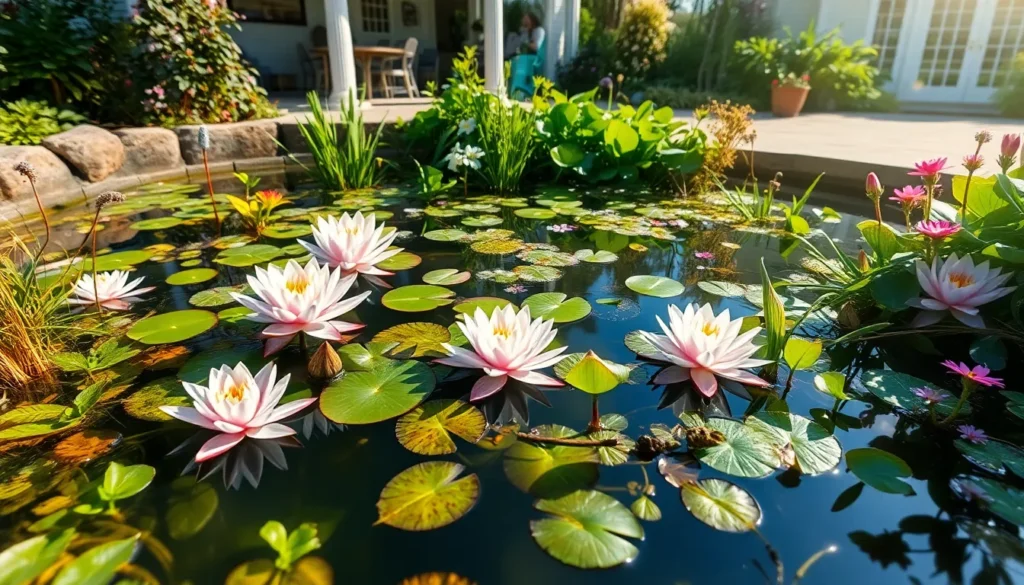We’ve all dreamed of creating that perfect backyard pond – a tranquil oasis that transforms our outdoor space into something truly magical. But here’s what most pond owners discover: without the right aquatic plants, even the most beautifully designed water feature can quickly become a maintenance nightmare filled with murky water and unwanted algae.
Water plants aren’t just decorative additions – they’re the living filtration system your pond desperately needs. These aquatic powerhouses work around the clock to balance nutrients, produce oxygen, and create crystal-clear water that’ll have your neighbors asking for your secret.
Whether you’re planning your first pond or looking to revitalize an existing water garden, choosing the right combination of floating, submerged, and marginal plants can mean the difference between a stunning centerpiece and a constant source of frustration. We’re here to guide you through the best water plants that’ll turn your pond into the low-maintenance paradise you’ve always wanted.
Choose Floating Water Plants for Natural Pond Coverage
Floating plants create natural shade while adding stunning visual appeal to your pond network. These water plants for ponds literally float on the surface, requiring no soil or special planting techniques to thrive.
Water Lilies for Classic Beauty and Shade
Water lilies offer the perfect combination of elegance and functionality for pond coverage. Their large, waxy leaves spread across the water surface, providing essential shade that keeps water temperatures cool and reduces algae growth. We recommend allocating 50-70% of your pond surface to these classic floating plants for optimal coverage.
Hardy water lilies like Nymphaea ‘Marliacea Chromatella’ survive winter temperatures and return each spring with bright yellow blooms. Tropical varieties such as Nymphaea ‘King of Siam’ produce vibrant purple flowers but require protection in colder climates. Most water lily varieties need 4-6 hours of direct sunlight daily to produce their signature blooms.
Plant water lilies in containers placed 12-24 inches below the water surface depending on the variety. Their roots anchor in soil while leaves and flowers float naturally on top, creating that picture-perfect pond aesthetic we all desire.
Water Hyacinth for Fast-Growing Coverage
Water hyacinth delivers rapid pond coverage with its thick, glossy leaves and spectacular purple flower spikes. These floating water plants multiply quickly, often doubling their coverage area within 2-3 weeks during peak growing season. We’ve seen single plants expand to cover 6-8 square feet in just one summer.
Their inflated leaf stems act as natural floats, keeping the entire plant buoyant without any anchoring system. Feathery roots dangle beneath the surface, absorbing excess nutrients that would otherwise fuel algae blooms. This makes water hyacinth an excellent biological filter for maintaining clear pond water.
Consider water hyacinth’s aggressive growth rate when planning your pond plant selection. Remove excess plants regularly to prevent overcrowding, or use them as natural compost for your garden beds. These plants prefer warm water temperatures above 70°F and full sun exposure for best performance.
Water Lettuce for Easy Maintenance
Water lettuce provides effortless pond coverage with minimal care requirements throughout the growing season. Their velvety, light green leaves form attractive rosettes that float freely across the water surface. Each plant typically spans 6-10 inches in diameter, making coverage calculations simple for pond planning.
These floating plants reproduce through runners, creating daughter plants that detach and establish independently. We find water lettuce easier to control than water hyacinth because of this slower reproduction method. Their compact root systems filter water effectively without becoming invasive like some other floating species.
Water lettuce thrives in partial shade to full sun conditions, adapting well to various pond environments. Remove yellowing or damaged leaves regularly to maintain healthy plant appearance and prevent decomposition in your pond water. These plants also serve as natural spawning areas for fish and provide shelter for beneficial pond wildlife.
Select Submerged Water Plants for Oxygen Production
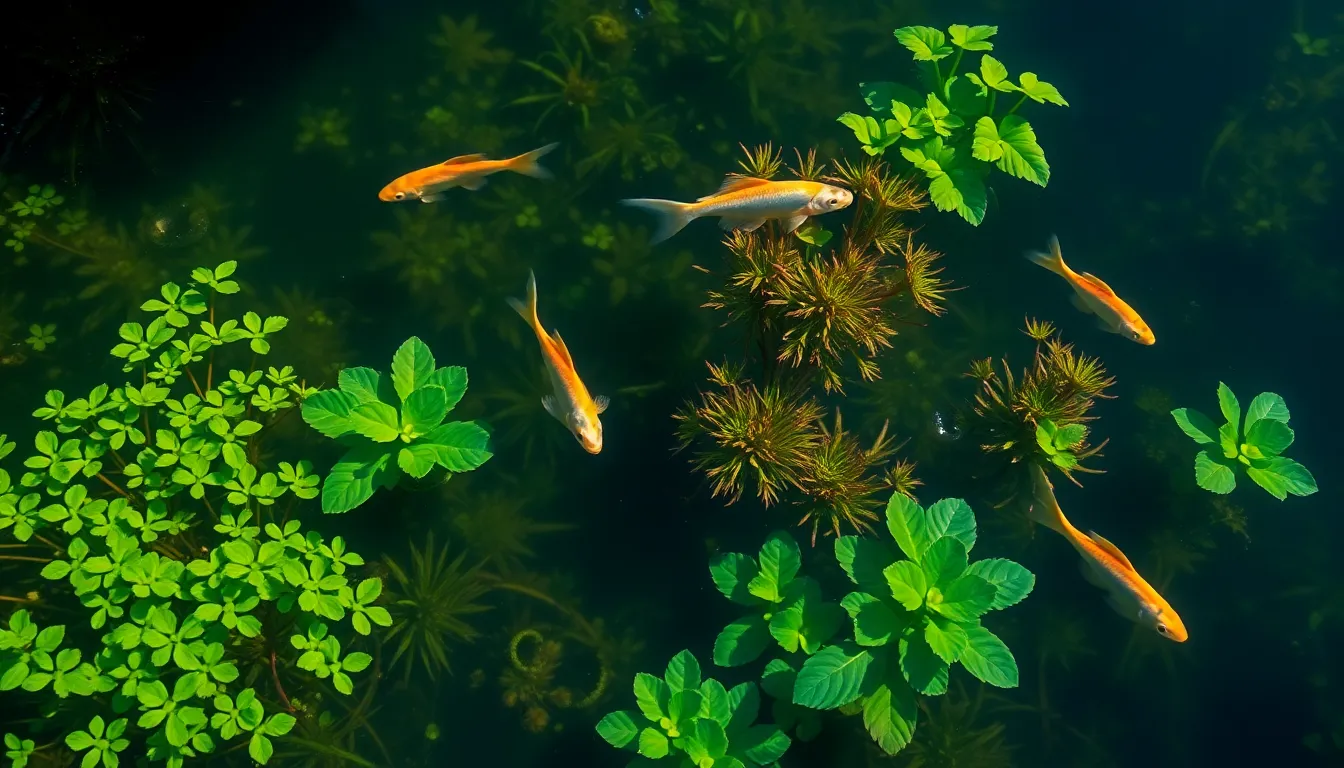
Submerged oxygenating plants work beneath the surface to maintain healthy pond ecosystems while creating essential oxygen for fish and other aquatic life. We’ll explore three top performers that excel at water oxygenation and natural filtration.
Hornwort for Maximum Oxygenation
Hornwort stands out as our top choice for rapid oxygen production and exceptional algae control throughout summer and autumn months. Growing quickly with distinctive feathery foliage, this adaptable plant thrives in various water conditions from cold to warm climates. Fish and tadpoles benefit from the excellent shelter it provides while the dense growth effectively suppresses unwanted algae. We recommend hornwort for pond owners seeking maximum oxygenation benefits with minimal maintenance requirements.
Cabomba for Delicate Underwater Foliage
Cabomba offers stunning aesthetic appeal with its delicate underwater leaves while contributing solid oxygenation performance to warm climate ponds. Creating beautiful underwater coverage, this plant adds visual interest below the surface as it produces oxygen and provides habitat for aquatic creatures. Warm weather regions see the best results from cabomba, though we don’t recommend it for colder climates due to its temperature sensitivity. Pond enthusiasts who prioritize both function and beauty often choose cabomba for its graceful appearance.
Vallisneria for Natural Filtration
Vallisneria excels as both a high oxygen producer and natural water filter, making it one of our most versatile submerged plant recommendations. Long ribbon-like leaves create effective filtration while promoting excellent oxygenation in both warm and cold climate conditions. Clear water conditions result from vallisneria’s natural ability to limit algae growth and filter pond water. Fish appreciate the spawning grounds and shelter these plants provide, while pond owners benefit from the reliable performance across different temperature ranges.
| Plant | Oxygenation Benefits | Climate Tolerance | Key Features |
|---|---|---|---|
| Hornwort | Maximum oxygen production, rapid growth | Cold to warm climates | Feathery foliage, algae control, fish shelter |
| Cabomba | Good oxygenation, aesthetic coverage | Warm climates only | Delicate leaves, underwater beauty |
| Vallisneria | High oxygen output, natural filtration | Cold to warm climates | Long leaves, water filtering, fish habitat |
Install Marginal Water Plants for Pond Edges
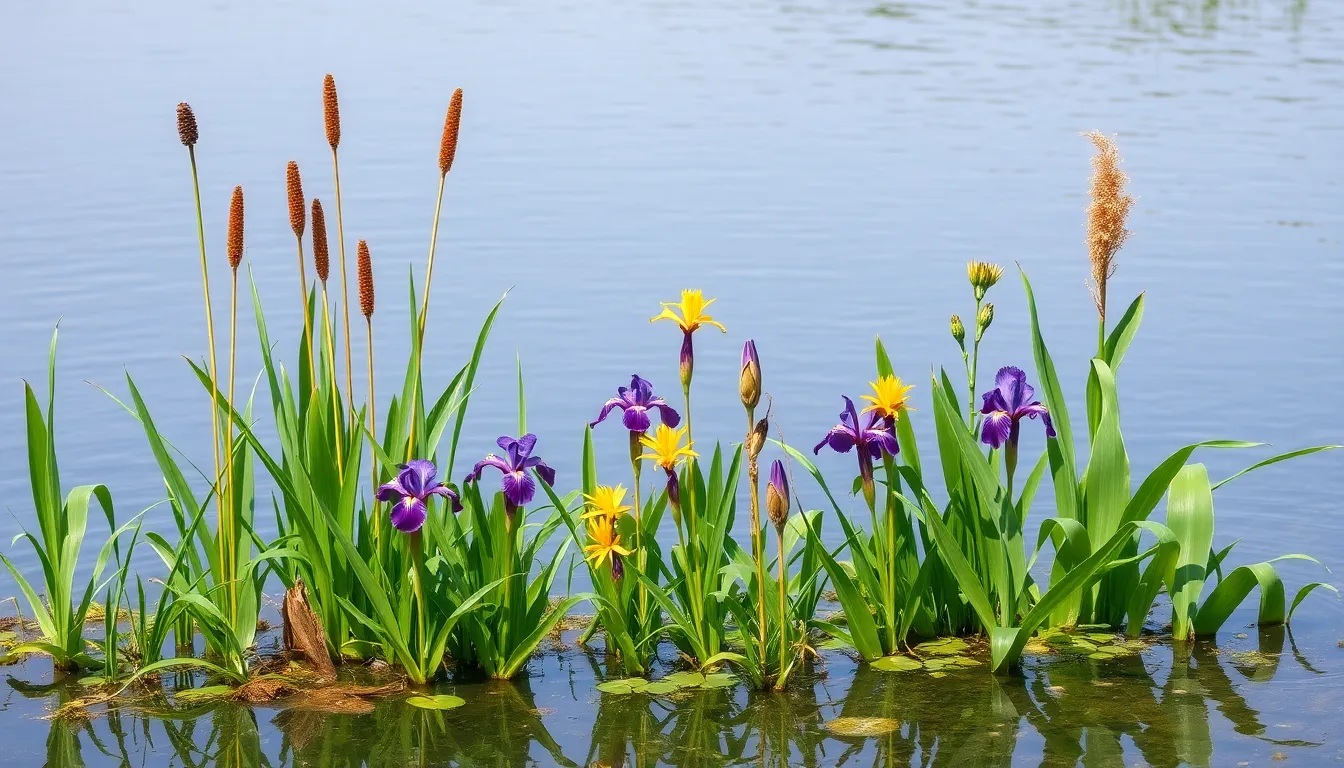
Marginal water plants complete our pond network by thriving in the shallow transition zone where water meets land. These essential plants create natural pond edges while filtering excess nutrients and providing wildlife habitat.
Cattails for Traditional Pond Aesthetics
Cattails bring classic charm to pond edges with their tall, slender stems and distinctive brown seed heads. We recommend planting them in shallow water or moist soil along your pond’s margins where they’ll create striking vertical elements. Their architectural form adds naturalistic beauty while serving practical functions like water filtration and oxygenation.
Wildlife benefits make cattails particularly valuable since they provide essential habitat for birds, frogs, and other pond creatures. Installing them is straightforward – we can plant them directly in gravel at pond edges or use containers buried at the water’s margin. Cattails thrive in marginal planting shelves designed with rocks or logs for structural support.
Water Iris for Colorful Blooms
Water iris species transform pond edges into vibrant displays with their showy purple, blue, and yellow flowers. We’ve found these plants excel in shallow water conditions while contributing to water filtration like other marginal species. Their seasonal blooms create stunning visual interest that complements the structural elements of cattails.
Planting techniques for water iris involve positioning them in wet soil or shallow water areas of your pond. They grow well in the same marginal shelves we use for cattails, making them perfect companions. Water iris plants add both beauty and functionality to your pond’s network.
Arrowhead Plants for Distinctive Foliage
Arrowhead plants offer unique arrow-shaped leaves that create striking foliage contrast against taller pond plants. We appreciate their distinctive architectural form which balances beautifully with flowering irises and vertical cattails. These plants thrive in shallow water and marshy pond margins while supporting network health.
Network contributions include effective water filtering and aquatic life shelter, making arrowhead plants valuable additions to marginal plantings. Installing them follows the same principles we use for other marginal species – shallow shelves with proper aquatic substrate or container placement at pond edges. Their distinctive leaf shape provides textural variety that enhances our pond’s overall visual appeal.
Consider Deep Water Plants for Large Ponds
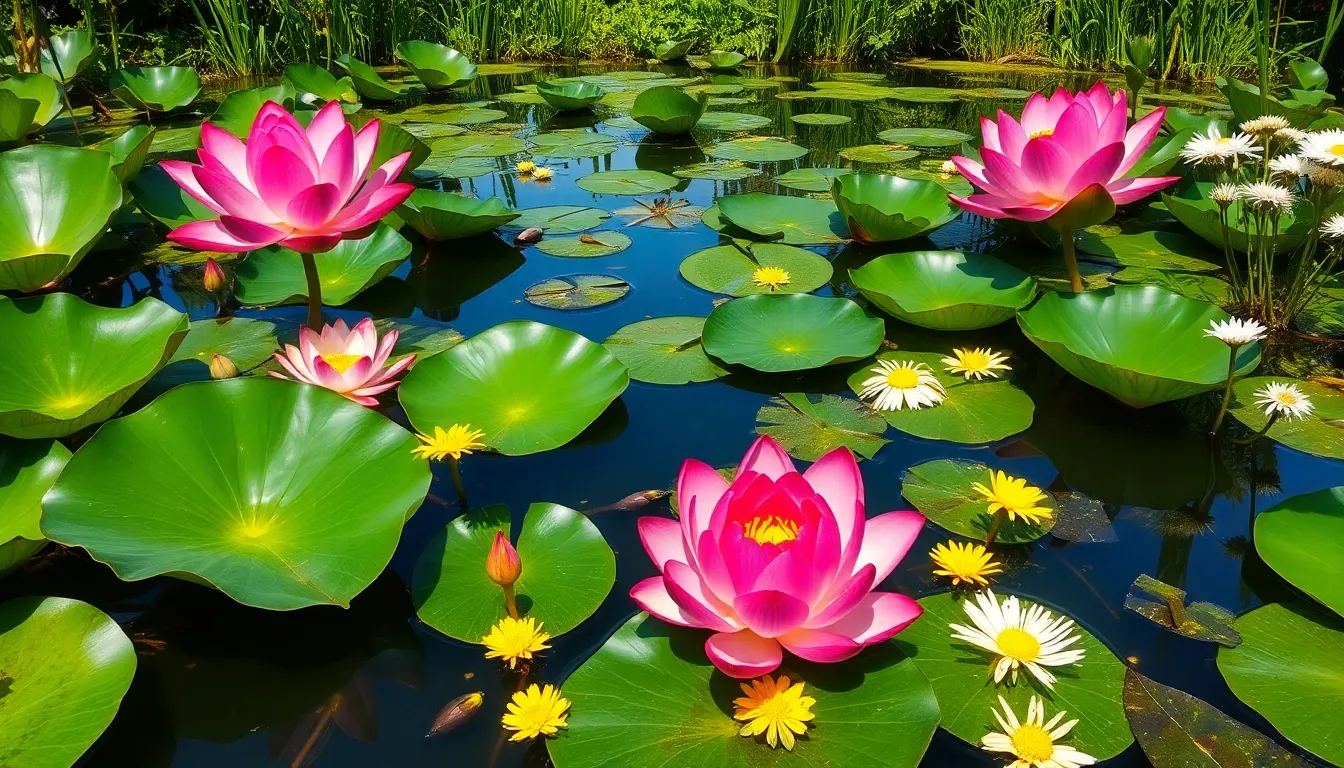
Deep water plants thrive in the deeper sections of large ponds where other aquatic plants can’t establish themselves. We recommend these varieties for their ability to provide oxygen through photosynthesis while creating natural filtration systems that improve water clarity and quality.
Lotus Plants for Spectacular Flowers
Lotus plants deliver the most dramatic visual impact with their large, showy flowers and elegant foliage that rise majestically above the water surface. We’ve found these emergent aquatic plants create stunning focal points while providing essential shade that cools water temperature and reduces sunlight penetration by up to 70%. Their broad leaves suppress algae growth naturally by blocking excessive light from reaching the water below.
Beyond their spectacular beauty, lotus plants offer crucial habitat and shelter for aquatic and semi-aquatic wildlife. Fish seek refuge under their expansive leaves during hot summer days, while amphibians use the sturdy stems and leaves as resting platforms. The flowers themselves attract beneficial pollinators, creating a thriving network that extends beyond the pond’s surface.
Spatterdock for Native Appeal
Spatterdock brings authentic native character to pond environments with its bright yellow flowers and large floating leaves that provide natural shade coverage. We appreciate this Nuphar species for its ability to support local wildlife food webs by serving as both a food source and shelter for aquatic animals. Native fish and amphibians rely on spatterdock’s dense foliage for protection and breeding habitats.
Stabilizing benefits make spatterdock invaluable for pond maintenance, as its robust root system anchors the pond bottom and shoreline areas. The plant reduces erosion naturally while filtering sediments and nutrients from the water column. We’ve observed that established spatterdock colonies create stable microclimates that benefit the entire pond network.
Water Snowflake for Unique Texture
Water snowflake adds distinctive visual interest with its fringed white flowers and delicate foliage texture that creates captivating surface patterns. We recommend this Nymphoides species for gardeners seeking unique aesthetic elements that differ from traditional pond plants. The intricate flower petals and lily pad-like leaves provide varied textures and visual depth.
Floating naturally on the surface, water snowflake moderates water temperature while reducing algae growth through strategic shading. Its root system acts as a natural water purifier by filtering excess nutrients that could otherwise fuel algae blooms. We’ve noticed that fish and aquatic invertebrates frequently shelter beneath these plants during the hottest parts of the day, benefiting from the cooler microenvironment they create.
Maintain Water Plants for Optimal Pond Health
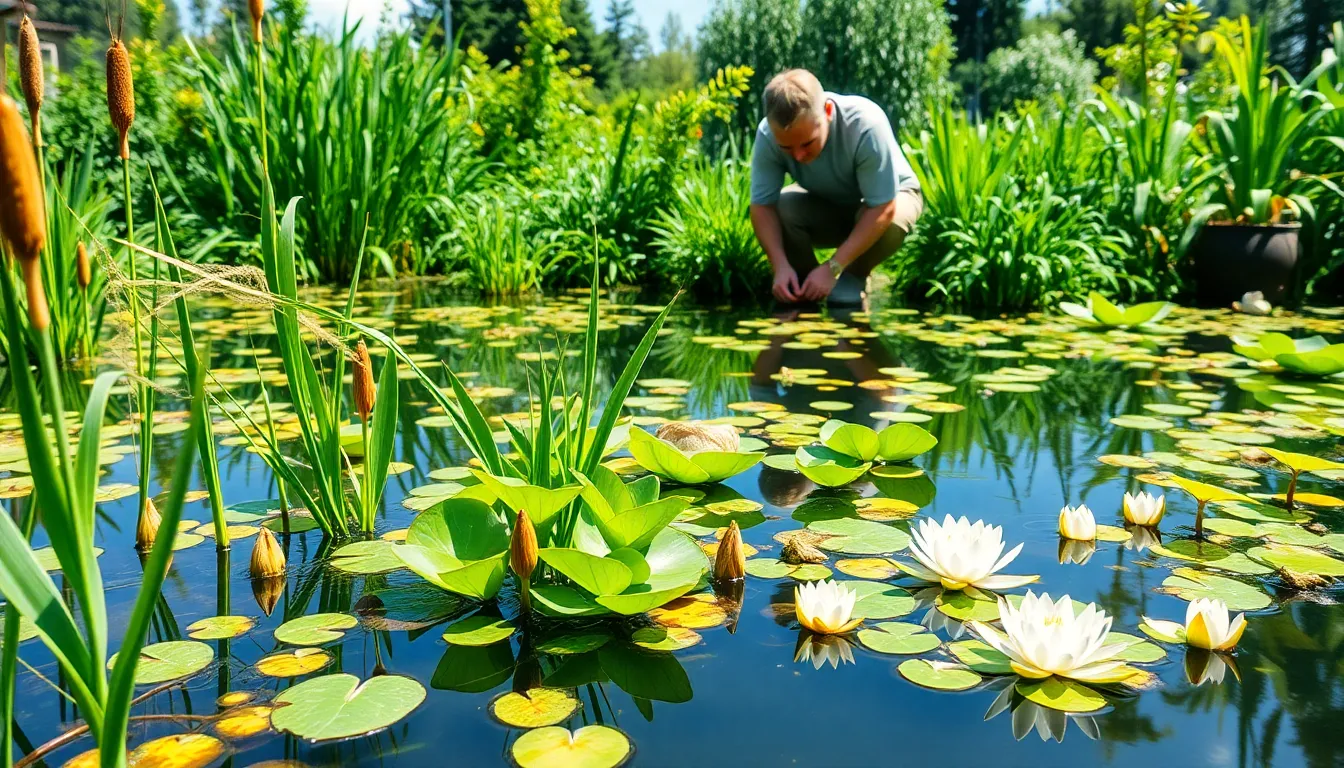
We’ve selected the perfect combination of aquatic plants for our pond, but maintaining them properly ensures they continue to filter water effectively and create that balanced network we’re after. Regular care keeps these natural filters working at peak performance while preventing common issues that can disrupt water quality.
Pruning Techniques for Overgrown Plants
Regular trimming of overgrown or dead foliage prevents decay that can pollute pond water and maintains optimal plant health. Dead leaves and stems that sink to the bottom create organic buildup that consumes oxygen and releases harmful compounds into the water.
Cut back lanky growth on plants like cattails and manna grass to encourage dense, healthy development while controlling their natural tendency to spread aggressively. Trimming these vigorous growers every 4-6 weeks during growing season maintains their filtering capacity without overwhelming other pond plants.
Remove excess growth strategically to improve water circulation and allow adequate light penetration to reach submerged plants below. Dense surface coverage looks beautiful, but too much foliage blocks essential sunlight that oxygenating plants need to photosynthesize effectively.
Trim floating plants like water hyacinth and water lettuce when they cover more than 70% of the surface area, as excessive coverage reduces oxygen exchange between water and air. Sharp, clean cuts made just above water level help prevent disease and encourage new growth.
Fertilizing Methods for Aquatic Plants
Slow-release aquatic fertilizers in tablet or pellet form provide essential nutrients without contaminating pond water when inserted directly into soil around plant roots. These specialized fertilizers dissolve gradually underwater, delivering nutrients where plants need them most.
Insert fertilizer tablets 2-3 inches deep into the growing medium around established plants every 4-6 weeks during active growing season. This targeted approach feeds plants directly while preventing nutrients from dispersing into open water where they could fuel algae growth.
Avoid over-fertilizing pond plants, as excess nutrients create algae blooms and water quality issues that can harm fish and disrupt the network balance we’ve worked to establish. Less is often more when feeding aquatic plants in closed pond systems.
Monitor water clarity after fertilizing to ensure nutrients aren’t causing unwanted algae growth or water discoloration. Clear water indicates proper nutrient balance, while green or murky water suggests we need to reduce fertilizer application.
Winter Care for Cold Climate Ponds
Hardy plants like marsh marigold naturally go dormant during winter months and should be cut back after the first frost to prevent decaying foliage from accumulating in pond water. This dormancy cycle is completely normal and plants will return vigorous in spring.
Remove plant debris thoroughly before winter sets in, as decomposing organic matter consumes oxygen that fish and beneficial bacteria need to survive under ice. Floating dead leaves and stems can create toxic conditions in sealed winter ponds.
Thin floating plants significantly before freezing temperatures arrive to prevent ice damage and maintain adequate oxygen levels for aquatic life throughout winter months. Dense plant coverage under ice can lead to dangerous oxygen depletion.
Move sensitive plants like tropical water lilies and water hyacinth indoors to containers filled with pond water when temperatures consistently drop below 50°F. These tender plants won’t survive freezing and require protection in heated spaces until spring returns.
Troubleshoot Common Water Plant Problems
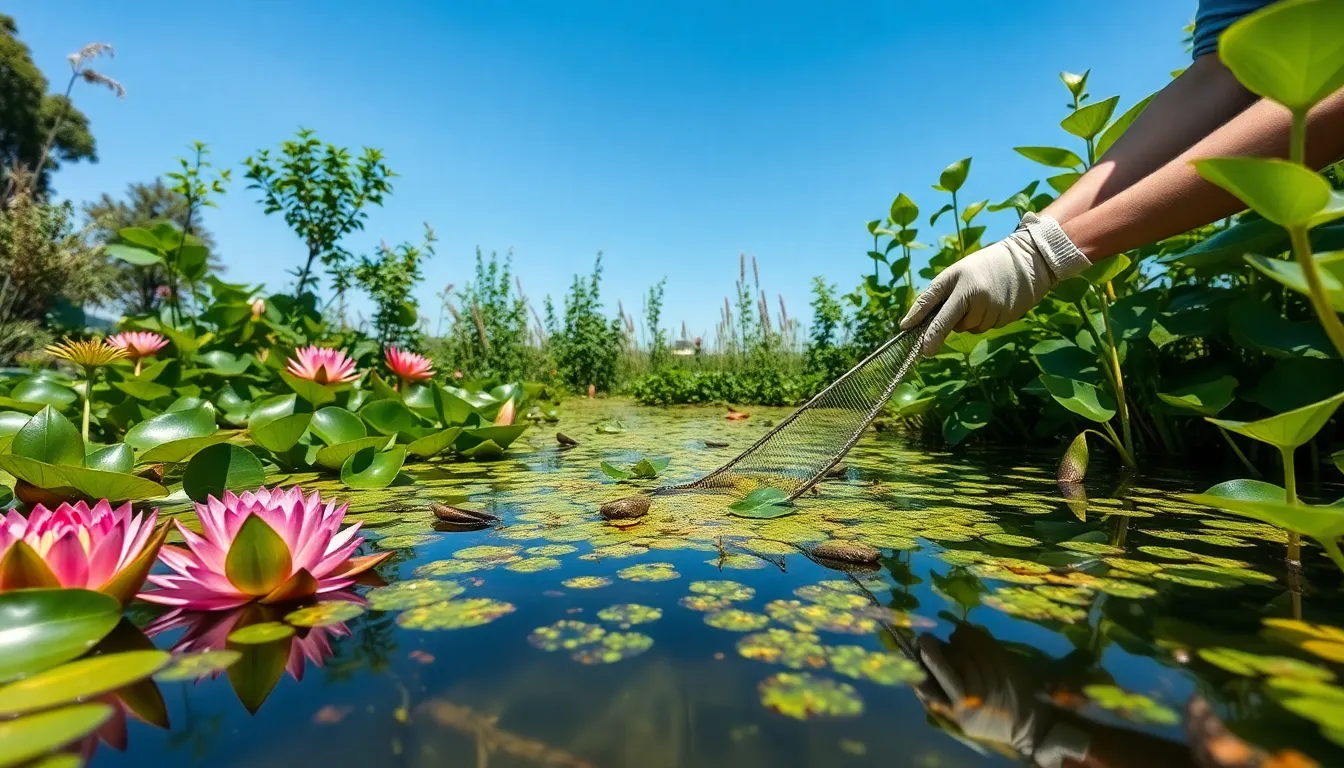
Even the most carefully planned pond plant selection can face challenges that require quick answers. We’ll guide you through the most common issues that affect pond plant health and water quality.
Managing Algae Competition
Algae becomes our biggest competitor when it starts stealing nutrients and light from our carefully chosen water plants. We need to balance nutrient levels since excess nutrients from fish waste, fallen leaves, or fertilizers directly fuel algae blooms that turn our pond water green and cloudy.
Floating plants serve as our natural algae fighters by creating shade that reduces the light algae needs to thrive. Water lilies and duckweed should cover 50-70% of our pond’s surface to effectively block sunlight from reaching algae below.
Beneficial bacteria products help us break down organic waste before it becomes algae food. UV clarifiers work alongside these bacteria to eliminate free floating algae spores that cloud our water.
Regular skimming removes algae mats before they decompose and release more nutrients back into our pond. Pond vacuums help us remove settled algae debris from the bottom where it can’t continue feeding future blooms.
Fish feeding habits directly impact algae growth since overfeeding creates excess nutrients. We should only feed our fish what they can consume in 2-3 minutes to prevent leftover food from decomposing and creating algae fuel.
Preventing Plant Overcrowding
Overcrowded plants compete for limited resources and create poor water circulation that leads to oxygen depletion. We must thin and harvest excess plants regularly to maintain the proper balance between plant coverage and open water.
Different plant types require exact spacing to thrive without competing. Submerged plants like hornwort need room to spread horizontally while marginal plants such as cattails require space between root systems to prevent nutrient competition.
Perennial plants need division every 2-3 years to prevent them from taking over our pond network. We should split rhizomes of cattails, water iris, and arrowhead plants during their dormant season to control their spread.
Growth monitoring helps us identify problem areas before overcrowding becomes severe. Fast growing species like water hyacinth can double their coverage in just two weeks, requiring weekly removal during peak growing season.
Seasonal adjustments allow us to prepare for different growth patterns throughout the year. Spring thinning prevents summer overcrowding while fall harvesting removes decaying plant material before winter.
Addressing Nutrient Deficiencies
Poor plant growth and yellowing leaves often indicate nutrient deficiencies that slow our pond’s natural filtration system. We need to test our water and sediment regularly to identify exact nutrient gaps before they affect plant health.
Aquatic plant fertilizers provide essential nitrogen, phosphorus, and potassium in slow release formulations designed for pond environments. These specialized fertilizers won’t dissolve quickly and create algae blooms like garden fertilizers would.
Fish populations contribute natural nutrients through their waste, but we need balanced numbers to avoid nutrient overload or deficiency. A general rule suggests one inch of fish per 10 gallons of water to maintain proper nutrient levels.
Organic matter additions require careful measurement since too much compost or mulch creates algae problems while too little starves our plants. We should add organic amendments sparingly and monitor water clarity for the following two weeks.
Testing schedules help us track nutrient trends and adjust our fertilization program accordingly. Monthly water tests during growing season and quarterly tests during dormant periods provide the data we need for targeted plant nutrition.
Plan Your Water Plant Layout for Maximum Impact
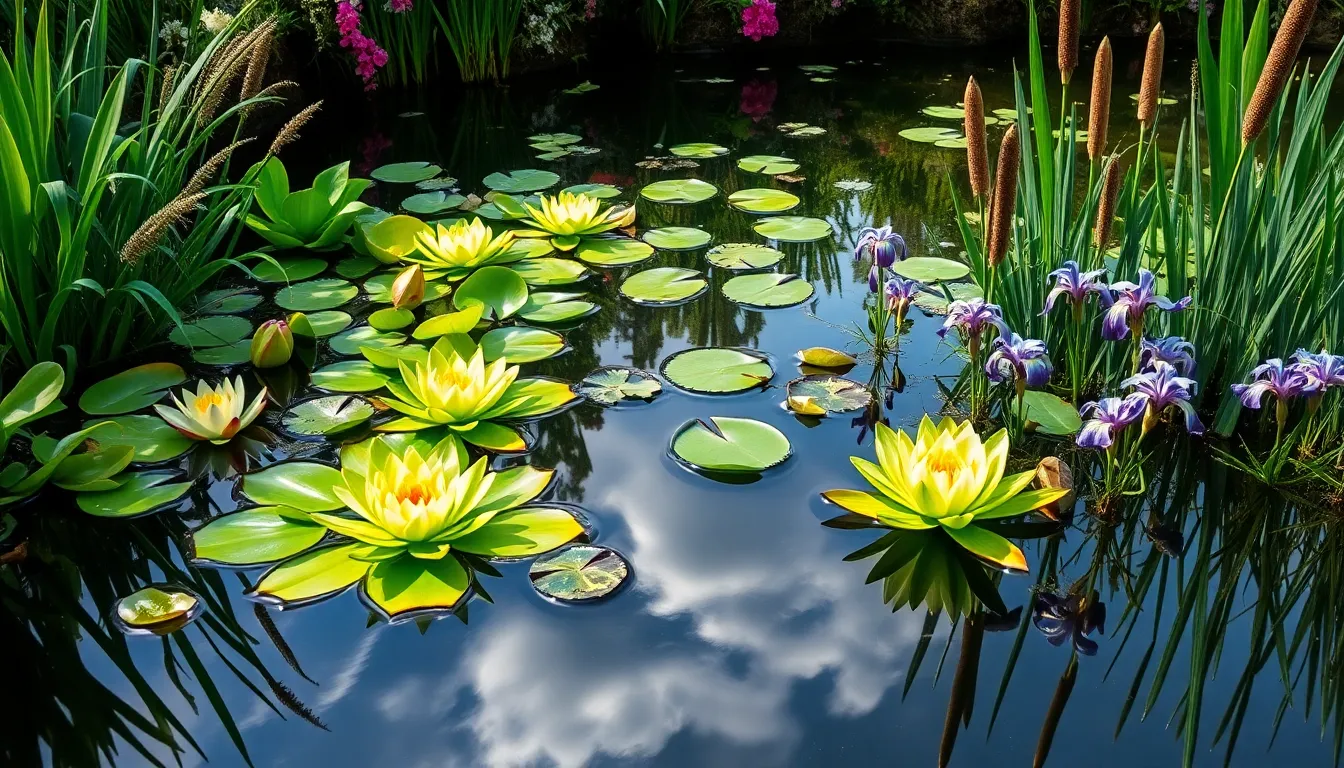
Designing an effective water plant layout requires strategic positioning to create both ecological balance and stunning visual appeal. We’ll maximize your pond’s health by carefully arranging different plant types across distinct zones.
Balancing Plant Types for Network Health
Creating a thriving pond network starts with incorporating three essential plant categories: floating, submerged, and emergent species. Floating plants like water hyacinth and water lettuce filter excess nutrients while preventing algae growth and providing shade for fish. Submerged plants work beneath the surface to oxygenate water and improve clarity through natural biological filtration. Emergent plants stabilize shorelines and add vertical structure while serving as food sources for fish, invertebrates, and waterfowl.
We recommend positioning these plants strategically to maximize their ecological functions. Place floating plants near the surface where they’ll absorb nutrients like nitrates and phosphates from fish waste and organic decay. Install submerged species in mid-depth zones where they’ll produce oxygen most effectively. Position emergent plants at pond edges where they’ll prevent erosion and create habitat for juvenile fish and wildlife.
This diverse plant community supports a healthy food web that keeps water clean and naturally filtered without artificial systems.
Creating Visual Interest with Plant Heights
Layered planting creates dramatic visual depth using the natural height differences of aquatic plants. Tall emergent plants along pond edges form an attractive backdrop while providing essential wildlife habitat. Mid-height floating plants add texture and surface interest across the water’s expanse. Low-growing submerged plants fill underwater spaces and maintain crystal clear water visibility.
We enhance aesthetic complexity by varying plant forms and foliage colors throughout these height layers. Dense cattails behind delicate water iris create striking contrasts. Colorful water lilies floating above feathery hornwort add textural richness. Bold arrowhead leaves paired with fine cabomba foliage provide visual balance.
Strategic height placement ensures each plant receives adequate sunlight while creating the lush, vibrant appearance that makes ponds truly spectacular.
Designing Seasonal Color Combinations
Year-round visual interest comes from selecting plants with staggered blooming periods and seasonal foliage changes. Spring bloomers like water iris provide early season color when other plants are just emerging. Summer flowering water lilies and lotus create peak season drama with their bold blooms. Fall foliage plants maintain interest as growing seasons wind down.
We combine native species that offer consistent habitat and food sources for aquatic life throughout changing seasons. Water snowflake provides unique texture in spring while spatterdock offers late summer blooms. Hardy water lilies transition beautifully from summer flowers to attractive seed pods in autumn.
This thoughtful seasonal planning ensures our pond remains colorful and attractive from spring through fall while supporting a sustainable, self-regulating aquatic environment that benefits both aesthetics and network health.
Conclusion
Transforming your backyard pond into a thriving aquatic network becomes achievable when you understand the vital role each plant type plays. We’ve shown you how the right combination of floating submerged and marginal plants creates a self-sustaining environment that’s both beautiful and functional.
Your success depends on choosing plants that work together rather than compete against each other. By following our strategic planting approach and maintenance guidelines you’ll enjoy crystal-clear water stunning seasonal displays and a healthy habitat for aquatic life.
Remember that patience pays off when establishing your pond’s plant community. Start with our recommended varieties monitor their growth patterns and adjust as needed. Your investment in quality aquatic plants will reward you with years of low-maintenance beauty and natural water filtration.
Frequently Asked Questions
What percentage of my pond surface should be covered by floating plants?
Floating plants like water lilies should cover 50-70% of your pond’s surface for optimal balance. This coverage provides natural shade, reduces algae growth, and helps maintain clear water while creating an attractive visual appeal. Too much coverage can reduce oxygen levels, while too little won’t provide adequate filtration benefits.
Which submerged plants are best for producing oxygen in my pond?
Hornwort, cabomba, and vallisneria are excellent oxygenating plants that work beneath the surface. Hornwort is particularly effective for rapid oxygen production and algae control, while vallisneria functions as both a high oxygen producer and natural water filter, thriving in various climate conditions.
How do I prevent my water hyacinth from taking over my entire pond?
Water hyacinth grows aggressively and can quickly cover large areas. Regularly remove excess plants to maintain proper coverage, typically keeping them to about 30-40% of your pond surface. You can compost removed plants or share them with other pond enthusiasts to manage their rapid reproduction.
When should I trim back my aquatic plants?
Trim aquatic plants regularly during the growing season to prevent overcrowding and maintain water circulation. Remove dead or yellowing foliage immediately to prevent decay that can pollute water. In cold climates, cut back hardy plants after the first frost and move sensitive plants indoors.
What’s the best way to fertilize aquatic plants without harming my pond?
Use slow-release fertilizers specifically designed for aquatic plants, placed directly in planting containers. Avoid over-fertilizing as this can promote algae growth. Monitor water clarity after fertilizing and reduce frequency if you notice increased algae or murky water conditions.
How do marginal plants benefit my pond ecosystem?
Marginal plants like cattails, water iris, and arrowhead create natural pond edges, filter excess nutrients, and provide wildlife habitat. They help stabilize pond banks, reduce erosion, and offer shelter for fish and beneficial insects while adding vertical interest and seasonal color to your water feature.
Can I grow lotus plants in a small backyard pond?
Lotus plants are better suited for larger ponds as they require significant space to spread and can become quite large. They need deep water sections and full sun exposure. For smaller ponds, consider dwarf lotus varieties or choose alternative floating plants like water lilies that are more proportionate.
How do I deal with algae competing with my aquatic plants?
Combat algae by maintaining proper plant coverage, especially floating plants that create shade. Introduce beneficial bacteria to help break down organic matter, ensure adequate plant diversity, and avoid over-fertilizing. Regular maintenance and proper plant balance naturally suppress algae growth through nutrient competition.
What should I do if my pond plants aren’t growing well?
Poor plant growth often indicates nutrient deficiencies, inadequate sunlight, or overcrowding. Test water quality, ensure plants receive appropriate light levels, thin overcrowded areas, and consider adding aquatic plant fertilizer. Also check that plants are suitable for your climate and water depth requirements.
How should I arrange different types of plants in my pond?
Create layers using floating plants for surface coverage, submerged plants for oxygenation, and marginal plants around edges. Position taller plants in back and shorter ones in front for visual depth. Plan for seasonal color combinations and maintain 50-70% total plant coverage for optimal ecological balance.

